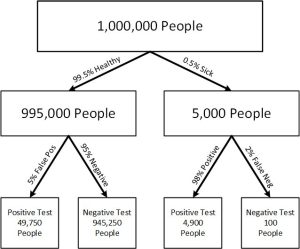I recommend Steven Pinker’s book (Amazon affiliate link) Rationality: What It Is, Why It Seems Scarce, Why It Matters and give it a five-star rating.
I am going to create a fictional medical situation and ask you to estimate the odds of a person being truly sick.
Let us assume for a moment that there is a new disease where 0.5 percent of the population is afflicted with the disease. If a random person not exhibiting any symptoms tested positive using a blood test, what are the odds that that person is truly sick knowing that the blood test has the following attributes:
- 98 percent of the sick people being identified as sick (true positive reading)
- 2 percent of the sick are falsely identified as okay (false negative reading)
- 95 percent of the healthy people identified as healthy (true negative reading)
- 5 percent of the healthy people being identified as sick (false positive reading)
Remember, this test is 98 percent accurate in identifying those that are sick as being sick. The answer of how many are truly sick may surprise you: it is about 9 percent.
To determine the 9 percent answer, we need to calculate the true positive readings and the total number of positive readings, which is false positive plus true positive readings.
For illustrative purposes, let us assume a total sample population of a million people.
False positive readings are calculated as follows: total sample population times percent healthy times false positive readings or 1,000,000 times 0.995 times 0.05 = 49,750 people.
Similarly, true positive readings are calculated as follows: total sample population times percent sick times true positive reading or 1,000,000 times 0.005 times 0.98 = 4,900 people.
Total positive reading = 4,900 + 49,750 = 54,650 readings.
Then, true positive readings are divided by total positive readings or 4,900 / 54,650 to get about 9 percent.
Please see figure 1. To enlarge the figure, click on it.
If this Bayesian theory example piqued your interest, then Rationality will be an interesting book for you to read. It discusses Bayesian theory and other similar statistical topics.
At the end of the book, Steven Pinker tells us why rationality matters. In short, if we want to progress as a society, we need to make rational choices.
I have always enjoyed these types of topics and therefore enjoyed this book and recommend it to those of you who enjoy similar topics.
As an aside, on his blog, David Epstein wrote an excellent article “Here’s How to Understand What a ‘95% Accurate’ Test Is Actually Telling You.” There, he references two good sources: one, the New York Times article “When They Warn of Rare Disorders, These Prenatal Tests Are Usually Wrong”; and two, JAMA Internal Medicine article “Medicine’s Uncomfortable Relationship With Math: Calculating Positive Predictive Value.” What is surprising is that the medical field itself has challenges with understanding Bayesian theory.
